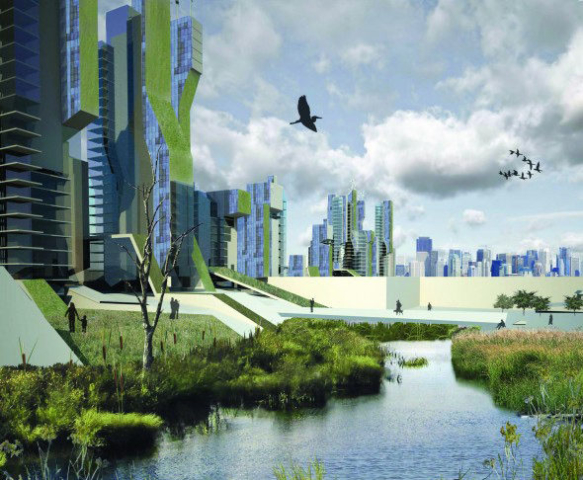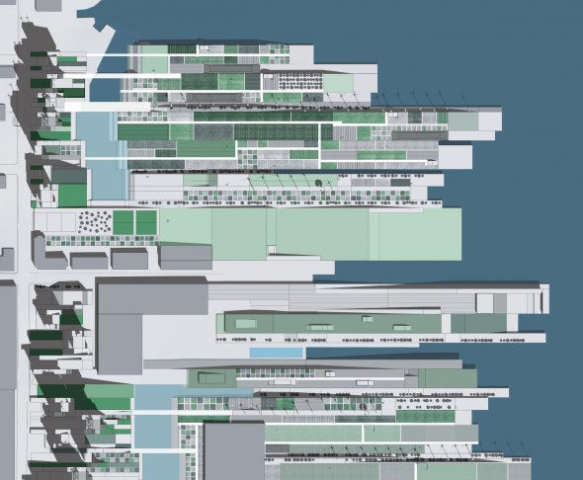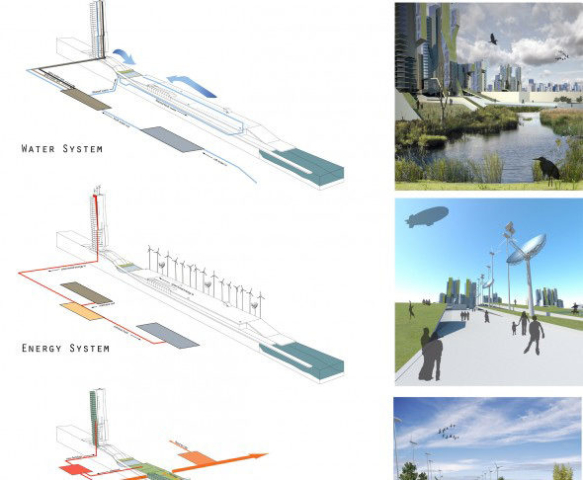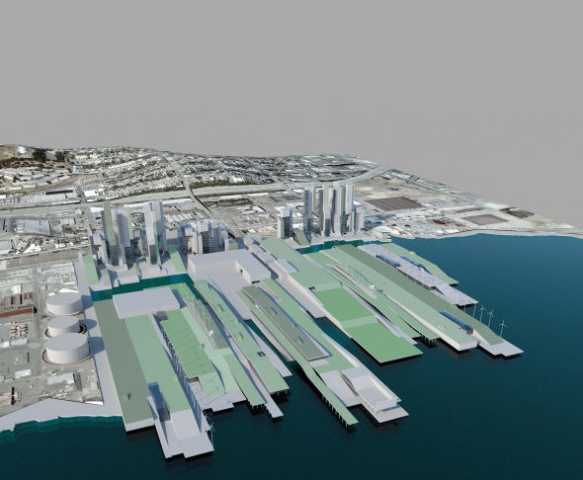Projekat: Jesen 2008.
Autori: Kyle Belcher, Dylan Barlow, Geoff Gregory
Klasa: Pier 70 Studio
Profesori: Mona El Khafif, David Fletcher
Nagrada: Prvo mesto na internacionalnom studentskom konkursu „Zelena zajednica“ u organizaciji ACSA asocijacije (Association of Collegiate Schools of Architecture), 2009.
Urbani greben, sistem inspirisan njegovim prirodnim pandanom, stvara raznovrsno i održivo socijalno i ekonomsko okruženje; produkuje hranu i energiju i prerađuje otpad, i uvek vraća uloženo u sistem i u grad. U vremenu kada nestašica nafte i nestašica hrane postaju realnost važno je da društvo ponovo preispita relacije između produkcije i potrošnje, naročito u vezi sa našim sistemom ishrane. Naša hrana putuje u proseku 1.500 milja od mesta gajenja do naših stolova i kako cena nafte raste, i novčano i ekološki, svi plaćamo višu cenu. Pošto se urbano tkivo menja sa promenama u globalnoj ekonomiji, odnos između lokacije konzumacije i sistema produkcije mora biti ponovo procenjen. Velike oblasti gradova u Americi su nedovoljno iskorišćene. Danas kada je tehnologija sveprisutna, održivost ne treba da znači odvajanje prirode i tehnologije, već njihovu hibridizaciju.
Kao i kod svakog grebena u prirodi, evolucija Urbanog grebena ne može se ostvariti preko noći i mora se osmisliti u vidu faznog razvoja. Tokom prvih 30 godina, trakaste tipologije, rekreativne zone, poljoprivredne škole, obradiva zemljišta, poslovanja biće implementirani u područje i postojaće težnja da se održe različite gustine stambenih i poljoprivrednih zona. Greben nije samo analogija za sistem proizvodnje već predstavlja i urbanističku strategiju. Diverzitet sistema (energija+hrana+otpad), ljudi (stanovnik baštovan+komercijalni poljoprivrednik) i aktivnosti (trgovina+rad+stanovanje+uzgajanje+odmor i razonoda) omogućuju dinamične društvene interakcije kao kod morskog grebena. Takođe slično prirodnom grebenu, rast sistema je fleksibilan i bazira se na potrebama tokom vremena. Trakaste tipologije Urbanog grebena mogu se promeniti u skladu sa pravcem razvoja grebena u zavisnosti od potreba sistema. Predložena šema i njeni kvadratni oblici predstavljaju jednu moguću konfiguraciju sistema.
Date: Fall 2008
Credit: Kyle Belcher, Dylan Barlow, Geoff Gregory
Class: Pier 70 Studio
Professor: Mona El Khafif, David Fletcher
Award: First Place ACSA Green Community International Students Competition, 2009
The Urban Reef is a system inspired by its natural aquatic counterpart, which creates a diverse and sustainable social and economic environment; It produces food and energy and processes waste, always feeding back into itself and the city. In a time where the idea of ‘Peak Oil = Peak Food’ is becoming reality, it’s imperative that societies rethink the relationships of production and consumption, especially regarding our food cycle. But as oil prices rise, both monetarily and environmentally – our food travels an average of 1,500 miles from the fields to your table – we all pay a higher price. As the American urban fabric changes with the reality of a global economy, our relationship of location of consumption to system of production must be re-evaluated. Vast areas of American cities lie under utilized as the fall of industrial processes’ open voids and provide an opportunity to shift the existing paradigm – from “brown fields” to “green fields”. In a post natural world where technology is omnipresent, sustainability should no longer be about the separation of technology and nature – but hybridization of the two.
Like any reef found in nature, the evolution of Urban Reef can not occur overnight and must be thought of in terms of a phased development. Over the course of 30 years, strip typologies; recreation areas, agricultural school, farmland, offices would be implemented across the site while always trying to maintain different densities of residential and agricultural areas. The reef is not purely an analogy for systems of production but also a strategy for urbanism. Diversity in systems (energy + food + waste), people (resident gardener + commercial farmer) and activities (shopping + working + living + growing + leisure) perpetuate dynamic social interactions like that of an ocean reef. Also similar to its natural counterpart, growth of the system is flexible based on needs over time. In the Urban Reef, strip typologies could change over the course of its development based on the needs of the system. So the proposed scheme and its corresponding square footages are only one possible configuration of the system.











